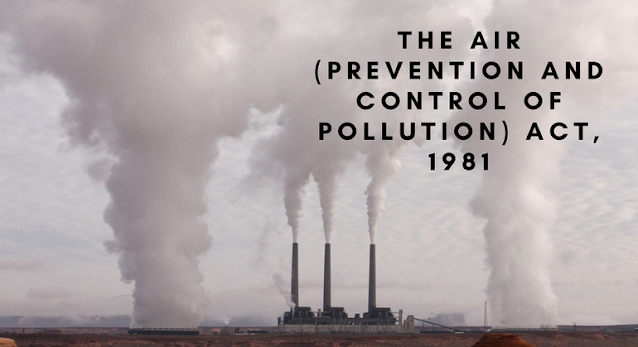 |
| The Air (Prevention & Control of Pollution) Act, 1981 |
The Act specifically empowers State Government to designate air pollution areas and to prescribe the type of fuel to be used in these designated areas. According to this Act, no person can operate certain types of industries including the asbestos, cement, fertilizer and petroleum industries without consent of the State Board. The Board can predicate its consent upon the fulfillment of certain conditions. The Air Act apparently adopts an industry wide “best available technology” requirement. As in the Water Act, courts may hear complaints under the Act only at the instigation of, or with the sanction of, the State Board.
The Government passed this Act in 1981 to clean up our air by controlling pollution. It states that sources of air pollution such as industry, vehicles, power plants, etc., are not permitted to release particulate matter, lead, carbon monoxide, sulfur dioxide, nitrogen oxide, volatile organic compounds (VOCs) or other toxic substances beyond a prescribed level. To ensure this, Pollution Control Boards (PCBs) have been set up by Government to measure pollution levels in the atmosphere and at certain sources by testing the air. This is measured in parts per million or in milligrams or micrograms per cubic meter. The particulate matter and gases that are released by industry and by cars, buses and two wheelers is measured by using air-sampling equipment. However, the most important aspect is for people themselves to appreciate the dangers of air pollution and reduce their own potential as polluters by seeing that their own vehicles or the industry they work in reduces levels of emissions. This Act is created to take appropriate steps for the preservation of the natural resources of the Earth which among other things includes the preservation of high quality air and ensures controlling the level of air pollution.
The main objectives of the Act are as follows:
(a) To provide for the prevention, control and abatement of air pollution.
(b) To provide for the establishment of central and State Boards with a view to implement the Act.
(C) To confer on the Boards the powers to implement the provisions of the Act and assign to the Boards functions relating to pollution
Air pollution is more acute in heavily industrialized and urbanized areas, which are also densely populated. The presence of pollution beyond certain Limits due to various pollutants discharged through industrial emission is monitored by the PCBs set up in every state.
Powers and Functions of the Boards
Central Pollution Board
The main function of the Central Board is to implement legislation created to improve the quality of air and to prevent and control air pollution in the country. The Board advises the Central Government on matters concerning the improvement of air quality and also coordinates activities, provides technical assistance and guidance to State Boards and lays down standards for the quality of air. It collects and disseminates information in respect of matters relating to air pollution and performs functions as prescribed in the Act.
State Pollution Control Boards
The State Boards have the power to advise the State Government on any matter concerning the prevention and control of air pollution. They have the right to inspect at all reasonable times any control equipment, industrial plant, or manufacturing process and give orders to take the necessary steps to control pollution.
They are expected to inspect air pollution control areas at intervals or whenever necessary. They are empowered to provide standards for emissions to be laid down for different industrial plants with regard to quantity and composition of emission of air pollutants into the atmosphere. A State Board may establish or recognize a laboratory to perform this function. The State Governments have been given powers to declare air pollution control areas after consulting with the State Board and also give instructions to ensure standards of emission from automobiles and restriction on use of certain industrial plants.
Penalties
The persons managing industry are to be penalized if they produce emissions of air pollutants in excess of the standards laid down by the State Board. The Board also makes applications to the court for restraining persons causing air pollution. Whoever contravenes any of the provision of the Act or any order or direction issued is punishable with imprisonment for a term which may extend to three months or with a fine of Rs 10,000 or with both, and in case of continuing offence with an additional fine which may extend to Rs 5,000 for every day during which such contravention continues after conviction for the first contravention.
